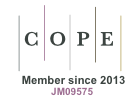Multilocus DNA analysis supports Didymodon gelidus (Musci, Pottiaceae) as a distinct endemic of the austral polar region
Abstract
Keywords
Full Text:
PDFReferences
Edwards SR. Taxonomic implications of cell patterns in haplolepidous moss peristomes. In: Clarke GCS, Duckett JG, editors. Bryophyte systematics. London: Academic Press; 1979. p. 317–346. (Systematics Association; vol 14).
Edwards SR. Homologies and inter-relationships of moss peristomes. In: Schuster RM, editor. New manual of bryology. Volume 2. Nichinan: The Hattori Botanical Laboratory; 1984. p. 658–695.
Ignatov MS, Spirina UN, Ignatova EA, Krug M, Quandt D. On the systematic position of the moss Catoscopium with a new approach to the peristome reduction study. Arctoa. 2015;24(2):389–415.
Olsson S, Enroth J, Huttunen S, Quandt D. Phylogeny of Neckeropsis and Himantocladium (Neckeraceae, Bryophytina). Bryophyt Divers Evol. 2016;38:53–70. https://doi.org/10.11646/bde.38.2.4
Alonso M, Jiménez JA, Nylinder S, Hedenäs L, Cano MJ. Disentangling generic limits in Chionoloma, Oxystegus, Pachyneuropsis and Pseudosymblepharis (Bryophyta: Pottiaceae): an inquiry into their phylogenetic relationships. Taxon. 2016;65:3–18. https://doi.org/10.12705/651.1
Akiyama H. Systematic study of the Yakushimabryum and related genera in the Pylaisiadelphaceae (Bryophyta). Acta Phytotaxonomica et Geobotanica. 2017;68(3):145–174. https://doi.org/10.18942/apg.201706
Enroth J, Shevock JR, Ignatov M. Mawenzhangia thamnobryoides (Bryophyta, Lembophyllaceae), a new moss genus and species from the Shangri-la region of Yunnan Province, China. Phytotaxa. 2018;346(3):237–246. https://doi.org/10.11646/phytotaxa.346.3.3
Ochyra R, Lewis Smith RI, Bednarek-Ochyra H. The illustrated moss flora of Antarctica. Cambridge: Cambridge University Press; 2008.
Ochyra R, Bednarek-Ochyra H, Lewis Smith RI. New and rare moss species from the Antarctic. Nova Hedwigia. 2008;87:457–477. https://doi.org/10.1127/0029-5035/2008/0087-0457
Ellis LT, Asthana AK, Gupta R, Nath V, Sahu V, Bednarek-Ochyra H, et al. New national and regional bryophyte records, 34. J Bryol. 2013;35(1):62–70. https://doi.org/10.1179/1743282012Y.0000000042
Ellis LT, Bednarek-Ochyra H, Ochyra R, Benjumea MJ, Saïs LV, Caparrós R, et al. New national and regional bryophyte records, 35. J Bryol. 2013;35(2):129–139. https://doi.org/10.1179/1743282013Y.0000000049
Bednarek-Ochyra H, Ochyra R. Diversity of Grimmiaceae subfam. Racomitrioideae in sub-Saharan Africa, including an addition of Bucklandiella striatipila to the moss flora of the continent. Cryptogam Bryol. 2013;34(1):3–12. https://doi.org/10.7872/cryb.v34.iss1.2013.3
Ochyra R, Crabtree D, Tangney R. Studies on mosses in the Falkland Islands: I. Bucklandiella and Codriophorus (Grimmiaceae). Cryptogam Bryol. 2015;36(3):289–310. https://doi.org/10.7872/cryb/v36.iss3.2015.289
Sollman P. The genus Bryoerythrophyllum (Musci, Pottiaceae) in Antarctica. Pol Bot J. 2015;50(1):19–25. https://doi.org/10.1515/pbj-2015-0004
Wilson W, Hooker JD. Musci. In: Hooker JD, editor. The botany of the Antarctic voyage of H. M. Discovery ships Erebus and Terror in the years 1839–43, under the command of Captain Sir James Clark Ross, Kt., R. N., F. R. S., & c. I. Flora antarctica. Part. II. Botany of Fuegia, the Falklands, Kerguelen’s Land, etc. London: Reeve Brothers; 1847. p. 395–423, 550–551 + pls. cli–clv.
Jiménez JA. Taxonomic revision of the genus Didymodon Hedw. (Pottiaceae, Bryophyta) in Europe, North Africa and Southwest and Central Asia. The Journal of the Hattori Botanical Laboratory. 2006;100:211–292.
Zander RH. Didymodon (Pottiaceae) in Mexico and California: taxonomy and nomenclature of discontinuous and nondiscontinuous taxa. Cryptogam Bryol Lichenol. 1981;2(4):379–422.
Ochyra R, Vitt DH, Horton DG. An annotated guide to Bryophyta Antarctica exsiccata. Cryptogam Bryol Lichenol. 1986;7(1):53–62.
Cardot J. Musci. In: Bell FJ, editor. National Antarctic Expedition 1901–1904. Natural history. Vol. 3. Zoology and botany (Invertebrata: Marine Algae, Musci). London: British Museum; 1907. p. 1–6 + pls. i–ii.
Dixon HN. Contribution to the Antarctic bryology. Bryologist. 1920:23(5):65–71. https://doi.org/10.1639/0007-2745(1920)23[65:CTAB]2.0.CO;2
Bartram EB. Mosses. Ann Mo Bot Gard. 1938;25:719–724. https://doi.org/10.2307/2394233
Ochyra R. Bryophyta Antarctica Exsiccata. Numbers 1–200. Edmonton: University of Alberta; 1984.
Ochyra R. The moss flora of King George Island, Antarctica. Kraków: W. Szafer Institute of Botany, Polish Academy of Sciences; 1998.
Seppelt RD, Green TGA. A bryophyte flora for southern Victoria Land, Antarctica. N Z J Bot. 1998;36:617–635. https://doi.org/10.1080/0028825X.1998.9512599
Ochyra R, Bednarek-Ochyra H, Lewis Smith RI. 170 years of research of the Antarctic moss flora. In: Głowacki P, Bednarek J, editors. Polish polar studies. 25th Polar Symposium. The 100th anniversary of Prof. Henryk Arctowski’s and Prof. Antoni Bolesław Dobrowolski’s participation in the Belgica expedition to the Antarctic in 1887–1889 [sic!]; 1998 Sep 16–17; Warsaw, Poland. Warsaw: Institute of Geophysics, Polish Academy of Sciences; 1998. p. 159–177.
Zander RH. Genera of the Pottiaceae: mosses of harsh environment. Bulletin of the Buffalo Society of Natural Sciences. 1993;32:1–378.
Zander RH, Ochyra R. Didymodon tectorum and D. brachyphyllus (Musci, Pottiaceae) in North America. Bryologist. 2001;104(3):372–377. https://doi.org/10.1639/0007-2745(2001)104[0372:DTADBM]2.0.CO;2
Ochyra R, Zander RH. The genera Didymodon and Bryoerythrophyllum (Pottiaceae) in Antarctica. J Bryol. 2002;24(1):33–44. https://doi.org/10.1179/037366802125000331
Jiménez JA, Ochyra R. Reinstatment of species rank for Didymodon gelidus (Bryophyta, Pottiaceae). Cryptogam Bryol. 2017;38(4):383–392. https://doi.org/10.7872/cryb/v38.iss4.2017.383
Saługa M, Ochyra R, Żarnowiec J, Ronikier M. Do Antarctic populations represent local or widespread phylogenetic and ecological lineages? Complicated fate of bipolar moss concepts with Drepanocladus longifolius as a case study. Org Divers Evol. 2018;18(3):263–278. https://doi.org/10.1007/s13127-018-0372-8
Hall TA. BioEdit: a user-friendly biological sequence alignment editor and analysis program for Windows 95/98/NT. Nucleic Acids Symp Ser. 1999;41:95–98.
Templeton, AR, Crandall AK, Sing CF. A cladistic analysis of phenotypic associations with haplotypes inferred from restriction endonuclease mapping and DNA sequence data. III. Cladogram estimation. Genetics. 1992;132:619–633.
Cano, MJ, Jiménez, JF, Alonso, M, Jiménez, JA. Untangling Pseudocrossidium crinitum s. l. (Pottiaceae, Bryophyta) through molecular and morphometric analysis. Nova Hedwigia. 2016;102:89–106. https://doi.org/10.1127/nova_hedwigia/2015/0290
Kučera J, Blockeel TL, Erzberger P, Papp B, Soldán Z, Vellak K, et al. The Didymodon tophaceus complex (Pottiaceae, Bryophyta) revisited: new data support the subspecific rank of currently recognized species. Cryptogam Bryol. 2018;39(2):241–257. https://doi.org/10.7872/cryb/v39.iss2.2018.241
Werner O, Jiménez JA, Ros RM, Cano MJ, Guerra J. Preliminary investigation of the systematics of Didymodon (Pottiaceae, Musci) based on nrITS sequence data. Syst Bot. 2005;30:461–470. https://doi.org/10.1600/0363644054782198
DOI: https://doi.org/10.5586/asbp.3609
|
|
|








